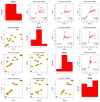Lepidium peruvianum as a Source of Compounds with Anticancer and Cosmetic Applications
- PMID: 39409148
- PMCID: PMC11476809
- DOI: 10.3390/ijms251910816
Lepidium peruvianum as a Source of Compounds with Anticancer and Cosmetic Applications
Abstract
Lepidium peruvianum-an edible herbaceous biennial plant distributed in the Andes-has been used for centuries as food and as a natural medicine in treating hormonal disorders, as an antidepressant, and as an anti-osteoporotic agent. The presented study aims to prove its beneficial cosmetic and chemopreventive properties by testing the antiradical, whitening, cytotoxic, and anticancer properties of differently colored phenotypes that were extracted using three solvents: methanol, water, and chloroform, with the help of the chemometric approach to provide evidence on the impact of single glucosinolanes (seven identified compounds in the HPLC-ESI-QTOF-MS/MS analysis) on the biological activity of the total extracts. The tested extracts exhibited moderate antiradical activity, with the methanolic extract from yellow and grey maca phenotypes scavenging 49.9 ± 8.96% and 48.8% ± 0.44% of DPPH radical solution at a concentration of 1 mg/mL, respectively. Grey maca was the most active tyrosinase inhibitor, with 72.86 ± 3.42% of the enzyme activity calculated for the water extract and 75.66 ± 6.21% for the chloroform extract. The studies in cells showed no cytotoxicity towards the human keratinocyte line HaCaT in all studied extracts and a marked inhibition of cell viability towards the G361 melanoma cell line, which the presence of pent-4-enylglucosinolate, glucotropaeolin, and glucoalyssin in the samples could have caused. Given all biological activity tests combined, the three mentioned compounds were shown to be the most significant positive contributors to the results obtained, and the grey maca water extract was found to be the best source of the former compound among the tested samples.
Keywords: Lepidium meyenii; antioxidants; cancer; cosmetics; glucosinolanes; glucotropaeolin; skin; tyrosinase inhibitors.
Conflict of interest statement
The authors declare no conflict of interest. The plant material was collected personally by Professor Henry O. Meissner during an expedition to the plantation where maca was cultivated and hand-picked during the annual harvest under the supervision of the owner of the plantation from whom the plant material was obtained, in full understanding that the samples taken were intended for complex analyses in laboratories in Poland by a group of scientists who are co-authors of this paper. The expedition was organized and financed by Professor Henry O. Meissner, who also helped with the collection and preliminary technical processing of the plant material from the plantation. The authors disclose no potential conflict of interest that could be related to the TTD company.
Figures









Similar articles
-
Synergism of Specific Maca Phenotypes (Lepidium peruvianum) in Combination with Saw Palmetto (Serenoa repens) Extract for Chemoprevention of Prostate Cancer as Determined in In Vitro Cytotoxicity Assays on Human Epithelial and Prostate Cancer Cells.Molecules. 2024 Nov 28;29(23):5632. doi: 10.3390/molecules29235632. Molecules. 2024. PMID: 39683791 Free PMC article.
-
Extraction, fractionation and re-fractionation of Artemisia nilagirica for anticancer activity and HPLC-ESI-QTOF-MS/MS determination.J Ethnopharmacol. 2018 Mar 1;213:72-80. doi: 10.1016/j.jep.2017.10.029. J Ethnopharmacol. 2018. PMID: 29109061
-
Extraction, purification and antioxidant activities of the polysaccharides from maca (Lepidium meyenii).Carbohydr Polym. 2014 Oct 13;111:584-7. doi: 10.1016/j.carbpol.2014.05.017. Epub 2014 May 21. Carbohydr Polym. 2014. PMID: 25037390
-
Chemical composition and health effects of maca (Lepidium meyenii).Food Chem. 2019 Aug 1;288:422-443. doi: 10.1016/j.foodchem.2019.02.071. Epub 2019 Feb 22. Food Chem. 2019. PMID: 30902313 Review.
-
Maca Cosmetics: A Review on Constituents, Therapeutics and Advantages.J Oleo Sci. 2018;67(7):789-800. doi: 10.5650/jos.ess18012. J Oleo Sci. 2018. PMID: 29962450 Review.
References
-
- Natural Cosmetics Market Size Analysis Report By Product (Skin Care, Hair Care, Fragrance, Color Cosmetics), By Distribution Channel (Supermarket/Hypermarket, Online), and Segment Forecasts, 2019–2025. [(accessed on 10 June 2024)]. Available online: https://www.grandviewresearch.com/industry-analysis/natural-cosmetics-ma....
-
- Sumit K., Vivek S., Sujata S., Ashish B. Herbal Cosmetics: Used for Skin and Hair. Inven. Rapid Cosmeceuticals. 2012;2012:1–7.
-
- Amberg N., Fogarassy C. Green Consumer Behavior in the Cosmetics Market. Resources. 2019;8:137. doi: 10.3390/resources8030137. - DOI
MeSH terms
Substances
Grants and funding
LinkOut - more resources
Full Text Sources
Medical
Research Materials
Miscellaneous

